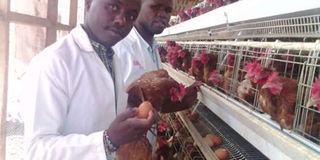Here’s why you need to network

Laban Muhia (left) and Godfrey Gura at a chicken farm in Thika. PHOTO | RACHEL KIBUI
What you need to know:
- Use a digital weighing scale to measure minerals, vitamins and amino acids because some measures are in grams.
- Koech said he had 450 Kari Improved Kienyeji chickens and he was struggling to feed them.
- “Most cereals like whole maize, maize germ and wheat have a CP of above 10 per cent,” I told the farmers as they listened keenly.
Two weeks ago, I met a group of eight poultry farmers on my farm in Njiru, Nairobi, to exchange ideas on feed formulation and other matters concerning poultry keeping.
Our interaction covered the science and art of preparing feeds at home, sourcing for raw materials, costing, weighing, mixing, packaging and testing for quality. We also had a hands-on practical session where the farmers made 70kg bags of chick, growers or layers mash.
I started the session by asking each participant to share their farming experiences and expectations. There was Nelson, a holder of a Bachelors in Animal Production. Musau said he was a principal of a secondary school in Kitui. He was accompanied by his daughter who had just completed Form Four and was interested in poultry farming.
Melly, on the other hand, was counting losses after buying 300 layers’ chicks that all turned out to be cocks. Betty wanted her farm to be more productive by applying modern farming methods and technology.
Koech said he had 450 Kari Improved Kienyeji chickens and he was struggling to feed them.
One thing that was clear from the named participants, and others, was that farmers are suffocating under the weight of high cost of poultry feeds.
Feeds account for 60-70 per cent of cost of producing eggs or meat from poultry. However, although home-made feeds accrue savings of between 30 and 50 per cent per 70kg bag, making quality feeds still remain a big challenge.
I explained to the farmers that productivity in animals is affected by genetics, feed conversion efficiency, quality of feeds and disease control.
Apart from quality feeds, one needs to consider the nutritional characteristics of feeds, cost, availability and palatability (effect on voluntary feed intake).
Just like humans, birds require a balanced diet comprising of carbohydrates, proteins, vitamins and minerals. I use maize germ, sunflower cake, wheat bran, premix, soymeal, lysine, methionine, salt and mycotoxin to prepare my poultry feeds. I don’t use wheat bran in chick mash because the excess fibre makes it unpalatable.
QUALITY OF INGREDIENTS
After selecting the ingredients carefully based on cost, availability and nutritional characteristics, I then grind them and measure based on standard formula, which says mix 34kg maize, 8kg maize germ, 6kg omena, 8kg of soy meal and methionine. This formulas have a scientific basis and give a required CP, say 18 for layers and chick mash.
Use a digital weighing scale to measure minerals, vitamins and amino acids because some measures are in grams.
Thereafter, mix using a drum mixer. Start with the minerals, vitamins and amino acids and mix these in a basin before putting in drum mixer.
Later, place in a sack and label as layers or growers, put a date and store in a dry place.
Lastly, it is also important to test the quality of ingredients and finished compound by doing a test called Proximate Analysis.
An important component of this test is the Crude Protein (CP), which is the basic nutritional requirement for any feed for animals and birds which a farmer contemplating making his or her own feeds must understand.
“Most cereals like whole maize, maize germ and wheat have a CP of above 10 per cent,” I told the farmers as they listened keenly.
On the other hand, sunflower and omena, the main sources of proteins, have a CP of between 20 and 30 and above 50 per cent respectively.
Therefore, for optimum growth and production, chicks require a CP of 18-20 per cent, growers 16-18 per cent and layers 18-10 per cent. “If the quality of the ingredients for making the feeds is poor, you get a low CP,” I added.
At the end of the lesson, we decided to form a network to share information on the best prices for raw materials and test results to avoid duplication.
We also agreed, where possible, to start thinking about how we can source raw materials in bulk and share transportation costs. Remember you get better savings if you buy in bulk.
We further resolved to share information about marketing and disease control by using a common vet.
Already, the network has started to bear fruit. I received an email from Benard who has found a credible source of limestone and methionine.
This is where most of us in the network are going to source the materials.





